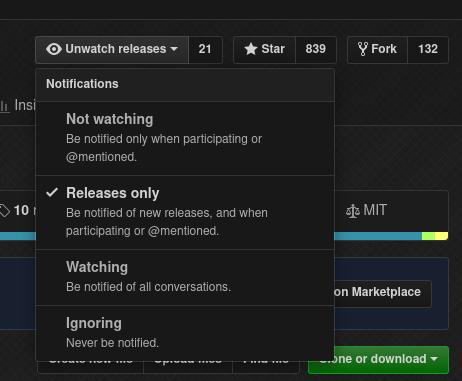Github CI for Stack Projects
How Github CI Works
Github CI is free to use and easy to set up. Being a native CI solution, it has great integration with the rest of the Github UI. Jobs run simultaneously, your dependencies can be cached, and your build artefacts can be processed. Haskellers will also appreciate that basic config with reasonable defaults for Haskell projects is much simpler than the corresponding config for Travis.
Config Definition
By virtue of commiting legal config to .github/workflows/, all subsequent pushes will use Github's CI, even in the PR that first introduces it. I typically call this file ci.yaml. This defines a Pipeline which can contain one or more Jobs. By writing another .yaml file to .github/workflows/, you define another independent Pipeline. These will run simultaneously, as do the Jobs themselves.
Actions
...
jobs:
build:
name: CI
runs-on: ubuntu-latest
steps:
- name: Setup GHC
uses: actions/setup-haskell@v1.1
with:
ghc-version: "8.8.3"
enable-stack: true
- name: Clone project
uses: actions/checkout@v2
...Github Actions are like standalone IO functions that alter the Pipeline's environment. We can see that the official setup-haskell Action has stack support built in, so we activate that and set our preferred GHC version with with. Notice that Actions have a version, which we can track by subscribing to releases:

Caching
You'll see config like this below:
- name: Cache dependencies
uses: actions/cache@v1
with:
path: ~/.stack
key: ${{ runner.os }}-${{ hashFiles('stack.yaml') }}
restore-keys: |
${{ runner.os }}-This is about as simple as a cache definition can be. Here are some things to keep in mind about Github CI caching:
- Every repo has a total limit of 5gb for all saved caches. If crossed, old caches are deleted.
- Caches are compressed with
tarbefore being saved. A 2.5gb.stack/compresses down to around 475mb. - Unused caches are deleted after 7 days.
- Caches saved on
mastercan be used on PR branches, but not the other way around. - Saved caches have a key that you can match on in later runs. Usually it looks for an exact match to the
key:field, but failing that, it falls back to patterns defined inrestore-key:. - Caches are immutable. If you had a partial match on a previous cache (and are thus using it), but your run changes the contents of the directory to save, a new cache will be saved with a new key.
For Haskell projects, I find that relying on the hash of the contents of stack.yaml is an accurate way to logically separate caches.
Configurations
Minimalist
If you have a stack-based project and just want simple CI, feel free to copy-and-paste the config below as-is.
The following YAML configuration means:
- Run CI upon every push to a PR.
- Run CI upon every push to
master. - Fetch this specific GHC version instantly, and don't cache it.
- Identify a cache based on the contents of
stack.yaml. When yourstack.yamlchanges, the saved cache will naturally update and be available to subsequent PRs.
name: Tests
on:
pull_request:
push:
branches:
- master
jobs:
build:
name: CI
runs-on: ubuntu-latest
steps:
- name: Setup GHC
uses: actions/setup-haskell@v1.1
with:
ghc-version: "8.8.3"
enable-stack: true
- name: Clone project
uses: actions/checkout@v2
- name: Cache dependencies
uses: actions/cache@v1
with:
path: ~/.stack
key: ${{ runner.os }}-${{ hashFiles('stack.yaml') }}
restore-keys: |
${{ runner.os }}-
- name: Build and run tests
run: "stack test --fast --no-terminal --system-ghc"Multiple LTS
The following YAML configuration means the same as above with respect to how often it's ran, but also says:
- Run three jobs simultaneously, overwriting the
resolverfield specified instack.yaml. - Even if one job fails early, don't cancel the other ones.
- Fetch each GHC version instantly, and don't cache them.
- Give each resolver its own cache. This lets them grow and stale independently.
name: Tests
on:
pull_request:
push:
branches:
- master
jobs:
build:
name: CI
runs-on: ubuntu-latest
strategy:
fail-fast: false
matrix:
resolver: ['lts-15.6', 'lts-14.27', 'lts-12.26']
include:
- resolver: 'lts-15.6'
ghc: '8.8.3'
- resolver: 'lts-14.27'
ghc: '8.6.5'
- resolver: 'lts-12.26'
ghc: '8.4.4'
steps:
- name: Setup GHC
uses: actions/setup-haskell@v1.1
with:
ghc-version: ${{ matrix.ghc }}
enable-stack: true
- name: Clone project
uses: actions/checkout@v2
- name: Cache dependencies
uses: actions/cache@v1
with:
path: ~/.stack
key: ${{ matrix.resolver }}-${{ hashFiles('stack.yaml') }}
restore-keys: |
${{ runner.os }}-${{ matrix.resolver }}-
- name: Build and run tests
run: >
stack test
--fast
--no-terminal
--resolver=${{ matrix.resolver }}
--system-ghcREADME Badges
Like you may be used to from other CI services, you can add a badge to your README to report recent build statuses. The token that appears after /workflows/ needs to be the same as the name: you put in your ci.yaml.
Markdown
Org Mode
[[https://github.com/fosskers/aura/workflows/Tests/badge.svg]]